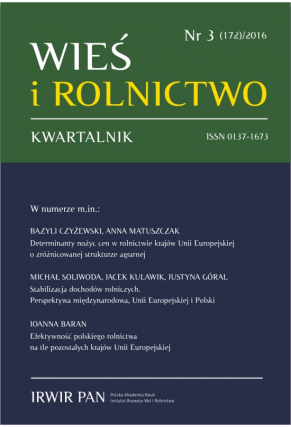The Role of Local Action Groups in the Process of Multifunctional Development of a Peripheral Region. A Case Study of the Region of Lublin, Poland
DOI:
https://doi.org/10.53098/wir032017/05Keywords:
Local Action Groups, Local Development Strategies, rural jobs, multifunctional developmentAbstract
The aim of the study is to describe the role of Local Action Groups (LAGs) under the Leader Programme in fostering entrepreneurship and employment in Lubelskie voivodeship. The hypothesis underpinning the study suggested that LAGs operating in rural areas of the Lublin region contribute insufficiently to job creation and provision of entrepreneurial incentives and play insufficient role in enhancing multifunctionality of rural areas. The study was based on document analysis and diagnostic surveys, including an interview questionnaire addressed to representatives of the offices of all 22 LAGs from the studied region. The results revealed that few projects were aimed at the development of non-agricultural functions in rural areas, and demonstrated insufficient involvement of LAGs in the implementation of projects in the bioeconomy sector, which is the key smart specialization of the region. In conclusion the authors assess the overall role of LAGs in creating jobs as marginal and call for paying more attention to the postulates of diversification assumptions resulting from the strategic development documents drafted for the region, including the Regional Innovation Strategy.References
Anderson C.R., Brushett L., Gray T.W., Renting H. (2014). Working together to build cooperative food systems. Journal of Agriculture, Food Systems, and Community Development, 4 (3), 3–9. DOI: https://doi.org/10.5304/jafscd.2014.043.017
Becla A., Czaja S. (2014). Rola kapitału ludzkiego i społecznego w określeniu ścieżki rozwoju ekonomicznego w regionach problemowych. Optimum: Studia Ekonomiczne, 2 (68), 16–28. DOI: https://doi.org/10.15290/ose.2014.02.68.02
Bosworth G., Annibal I., Carroll T., Price L., Sellick J., Shepherd J. (2016). Empowering local action through neo-endogenous development: The case of LEADER in England. Sociologia Ruralis, 56 (3), 427–449. DOI: https://doi.org/10.1111/soru.12089
Dargan L., Shucksmith M. (2008). LEADER and innovation. Sociologia Ruralis, 48 (3), 271–294. DOI: https://doi.org/10.1111/j.1467-9523.2008.00463.x
Ekosgen (2011). National impact assessment of leader report for DEFRA.
Elliott J. (2010). DEFRA: Rural development programme for England 2007–2013: mid-term evaluation, (1), Hyder and ADAS.
Guzal-Dec D. (2014). Partnerstwa międzysektorowe – lokalne grupy działania jako instrument wykorzystania zasobów lokalnych w procesie zrównoważonego rozwoju obszarów przyrodniczo cennych województwa lubelskiego. Roczniki Naukowe SERiA, 16 (4), 109–114.
Guzal-Dec D. (2016a). Leader initiative as a factor of social innovations in the development of the environmentally valuable areas of Lublin Region (Poland). In: K. György (ed.). XV Nemzetközi Tudományos Napok “Innovációs kihívások és lehetösé 2014–2020 között: a tudományos napok publikaćiói” (pp. 605–613). Gyöngyös: Károly Róbert Föiskola.
Guzal-Dec D. (2016b). Local Action Groups in the development of rural areas in Lubelskie voivodeship (Poland). Proceedings of the 2016 International Conference „Economic Science for Rural Development”, (42), Jelgava, LLU ESAF, 21–22 April, 65–71.
Guzal-Dec D., Zwolińska-Ligaj M. (2015). Propozycja modelu instytucjonalno-organizacyjnego wsparcia wykorzystania zasobów i walorów środowiska przyrodniczego w procesach stymulowania rozwoju obszarów przyrodniczo cennych. In: D. Guzal-Dec, A. Siedlecka, M. Zwolińska-Ligaj, Ekologiczne uwarunkowania i czynniki rozwoju funkcji gospodarczych na obszarach przyrodniczo cennych województwa lubelskiego (pp. 267–273). Biała Podlaska: Wydawnictwo PSW JPII.
Guzal-Dec D., Zwolińska-Ligaj M. (2016). The impact of Leader Programme on entrepreneurship and employment in the context of multifunctionality of rural areas. A case study of UE peripheral region (Lublin voivodeship, Poland). http://ageconsearch.umn.edu/bitstream/249763/2/160_EAAE_Seminar_Guzal-Dec_Zwoli%C5%84ska-Ligaj_4_12_16_fin.pdf [accessed: 15.01.2017].
http://www.ksow.pl [accessed: 10.05.2016].
Implemenation of the Leader approach for rural development, Special Report 5 (2010), European Court of Auditors.
Katalog LGD – lokalne grupy działania i ich działalność na obszarach wiejskich (2012). Warszawa: Ministerstwo Rolnictwa i Rozwoju Wsi.
Kisiel R., Gierwiatowska M. (2013). Functioning of the Polish LAG in the Context of the Leader Initiative. Acta Scientiarum Polonorum. Oeconomia, 12 (3), 39–50.
Kovách I. (2000). LEADER, a new social order, and the Central- and East-European Countries. Sociologia Ruralis, 40 (2), 181–189. DOI: https://doi.org/10.1111/1467-9523.00140
Krievina A., Leimane I., Melece L. (2015). Role of Local Action Groups in addressing regional development and social problems in Latvia. Research for rural development, 2, 146–153.
Labianca M., De Rubertis S., Belligiano A., Salento A. (2016). Innovation in rural development in Puglia, Italy: Critical issues and potentialities starting from empirical evidence. Studies in Agricultural Economics, 118, 38–46. Lafleur M., Merrien A.M. (2012). The Socio-Economic Impact of Cooperatives and Mutual. IRECUS. DOI: https://doi.org/10.7896/j.1531
Leszczewska K. (2010). Aktywność ekonomiczna regionów peryferyjnych. Nierówności społeczne a wzrost gospodarczy. Spójność społeczno-ekonomiczna a modernizacja gospodarki, 17, 215–225.
Miszczuk A. (2013). Uwarunkowania peryferyjności regionu przygranicznego. Lublin: Norbertinum. Nardone G., Sisto R., Lopolito A. (2010). Social capital in the LEADER initiative: A methodological approach. Journal of Rural Studies, 26 (1), 63–72. DOI: https://doi.org/10.1016/j.jrurstud.2009.09.001
Nembhard J.G. (2014). Benefits and impacts of cooperatives. Grassroots Economic Organizing (GEO) Newsletter, 2, Theme 18.
Raport końcowy. Ocena funkcjonowania lokalnych grup działania realizujących lokalną strategię rozwoju w ramach PROW 2007–2013 (2012), http://ksow.pl/fileadmin/user_upload/ksow.pl/pliki/ANALIZY_ekspertyzy/LGD_raport_poprawiony_ost_bis_10_09_2012.pdf [accessed: 20.06.2016].
Raport końcowy. Ocena wpływu PROW 2007–2013 na jakość życia na obszarach wiejskich z uwzględnieniem podejścia LEADER (2016). http://www.minrol.gov.pl/Wsparcierolnictwa/Program-Rozwoju-Obszarow-Wiejskich-2007-2013/Dokumenty-analizyraporty/Analizy-i-raporty [accessed: 20.06.2016].
Teilmann K. (2012). Measuring social capital accumulation in rural development. Journal of Rural Studies, 28, 458–465. DOI: https://doi.org/10.1016/j.jrurstud.2012.10.002
Terluin I.J. (2001). Rural Regions in the EU: Exploring Differences in Economic Development. Groningen: Rijksuniversiteit Groningen.
Zwolińska-Ligaj M. (2015a). Functional classification of rural areas in the Lubelskie Voivodship including their natural values. Barometr Regionalny, 13 (1), 67–75. DOI: https://doi.org/10.56583/br.965
Zwolińska-Ligaj M. (2015b). Integracja funkcji gospodarczych i środowiskowych na obszarach przyrodniczo cennych województwa lubelskiego. Perspektywa przedsiębiorstw. Biała Podlaska: Wydawnictwo PSW w Białej Podlaskiej.
Downloads
Article file downloads
Pages
How to Cite
Issue
Section
License
Copyright (c) 2017 Wieś i Rolnictwo

This work is licensed under a Creative Commons Attribution 4.0 International License.










